Select or Assign Signers
Once all documents have been uploaded, the next step in creating a package is entering signer information. Depending on whether your package includes a signing template, you are brought to either the Assign Signers to Roles screen or Select Signers screen:
Assign Signers to Roles Screen
|
Select Signers Screen
|
|
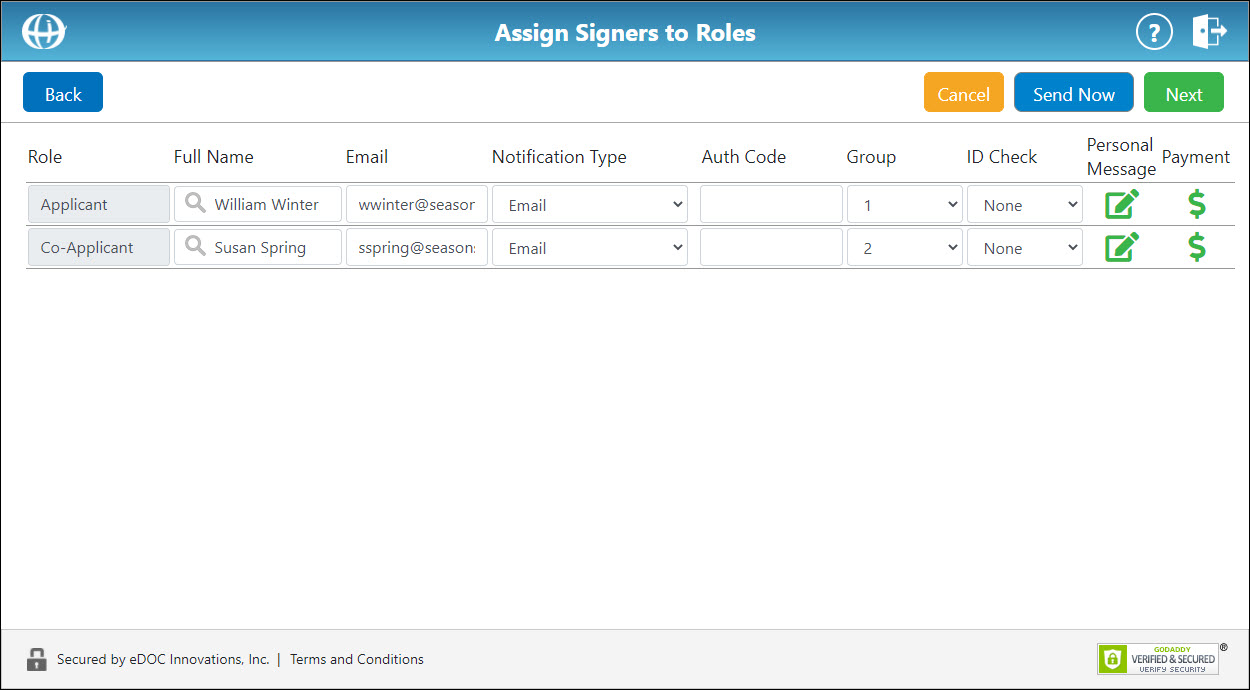 |
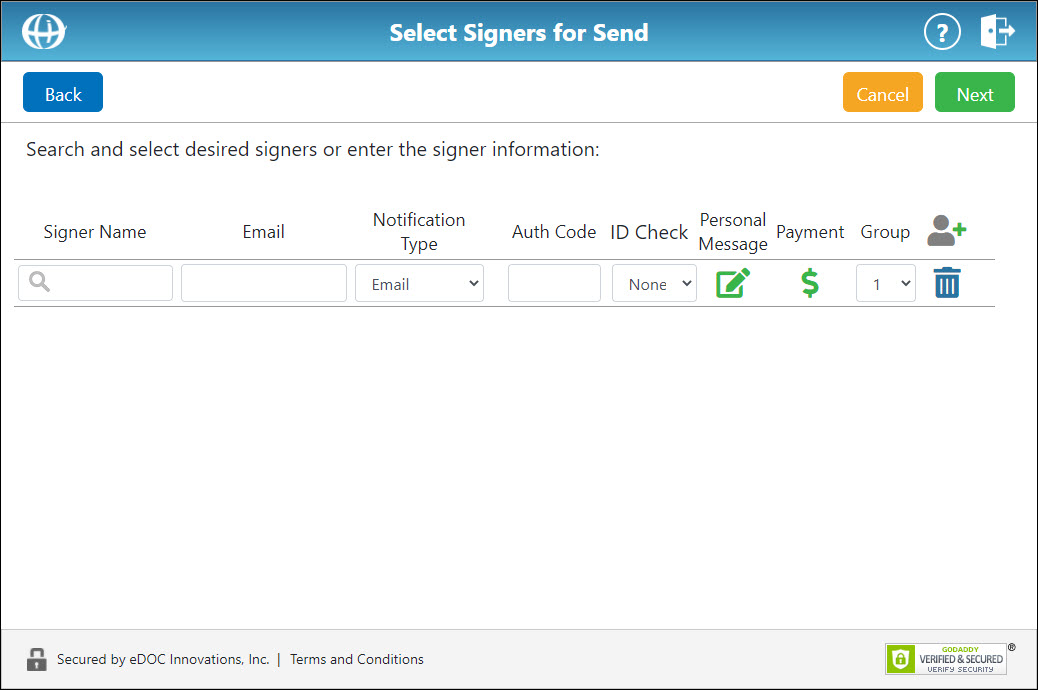 |
|
|
Packages that include a signing template bring users to the Assign Signers to Roles screen. This screen allows you to modify default signer role information already associated with the included signing template. For example, you can change a signer role's default signer name and email address. |
Packages that do not include a signing template bring users to the Select Signers screen. This screen allows you to enter new signer information or search for signers already in your eDOCSignature system. |
Assign Signers to RolesAssign Signers to Roles
Default signer role names and email addresses are entered when a template is first created. New roles cannot be added to a signing template at this time. To add a role to an existing template, you must edit the template from the Set Up Templates screen.

- To change the default signer name for a signer, in the corresponding Full Name field, enter a new signer name.
Alternatively, you can search for signers already in the system. To search for existing signers, enter at least four characters into the Full Name field and click the Search icon .
. - To change the default email address for a signer, in the corresponding Email field, enter a new email address.
To protect identity during the signing process, it is recommended that you use only one signer per email address. To accommodate signers that share an email, the following best practice is recommended:
- Assign the first signer to "Group 1."
- Assign the second signer to "Group 2."
- Call each signer separately to deliver their authorization codes.
This process will send an email notification to the first signer. After the first signer has completed the signing process, an email notification will be sent to the second signer.
- From the Notification Type drop-down list, select a notification type.
View Notification Type DescriptionsView Notification Type Descriptions
When a package is sent, a notification is sent to each signer. There are four message notification types in eDOCSignature from which you can select when sending packages out for signing: Public, Text, Private, and No Email:
- Email – An email notification is sent to the signer. The email includes a hyperlink that brings the signer to the eDOCSignature signing pages.
- Text – A text message notification is sent to the signer. The text message includes a hyperlink that brings the signer to the eDOCSignature signing pages. This feature must be enabled by eDOC Client Development before it can be selected.
- Home Banking – An email notification is sent to the signer informing them to log in to their home banking site. Once logged in, the signer can view an additional message containing more information that has been transmitted to the home banking site via the message submission API. This additional message contains the hyperlink that brings the signer to eDOCSignature's signing pages.
- No Email – No email notification is sent to the signer. This option is mostly used for in-person (i.e. in-branch) signing.
- To require an authentication code for a signer, in the corresponding Auth Code box, enter an authentication code.
View Authentication Code DescriptionView Authentication Code Description
An authentication code is a security tool that can be used to help verify the identity of a signer. When an authorization code is entered for a signer, an email is sent to that signer containing the authorization code. During the document signing process, the signer is prompted for this code and must enter it before proceeding any further. Authentication codes can be a combination of up to six letter and numbers.
- To change the grouping order of signers, from the Group drop-down list for each signer, select a group number.
View Grouping Order DescriptionView Grouping Order Description
Grouping order refers to the order in which signers receive a document for signing. For example, if two signers are set to be included in "Group 1" and one signer is set to be included in "Group 2," the signer in "Group 2" will not receive the document for signing until both signers in "Group 1" have completed the signing process.
- To require an ID Check for a signer, from the ID Check drop-down list, select an ID Check type.
View ID Check Type Descriptions View ID Check Type Descriptions
ID Check allows you to verify a signer's identity before the document signing process occurs using one of the methods described below. Access to each ID Check method is subscription-based and must be enabled by a member of the eDOC Client Development team.
IDology is an out-of-wallet service that screens signers using their personal information and a series of personalized questions. The service scours billions of public data records to intelligently derive tactful, non-invasive quesitons to authenticate an identity.
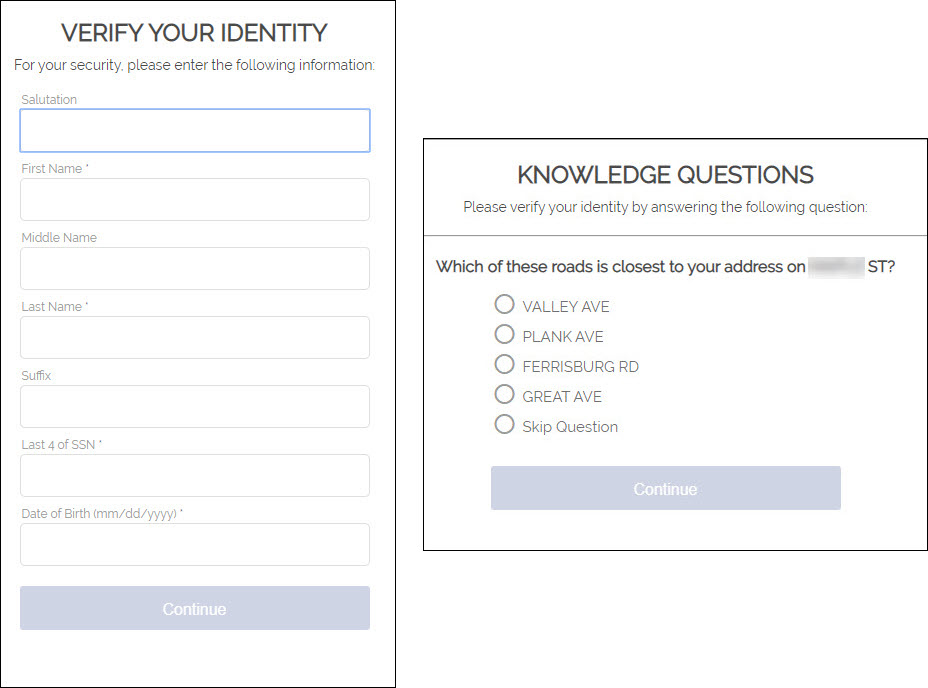
For each question, the signer has the option to choose "None of the Above" or "Skip the Question." Based on the number of questions answered correctly, your business can approve or deny the transaction. Once IDology confirms the signer's identity, they proceed to complete the signing process.
IDPal verifies a signer's identity by matching the information on their passport or driver's license with public data records. It also performs a "likeness test" using the signer's passport or driver's license photo and a current photo. Signers are sent a link to download the ID-Pal application on their mobile device. Once downloaded, signers use the application to upload a copy of their passport or driver's license as well as a current photo.
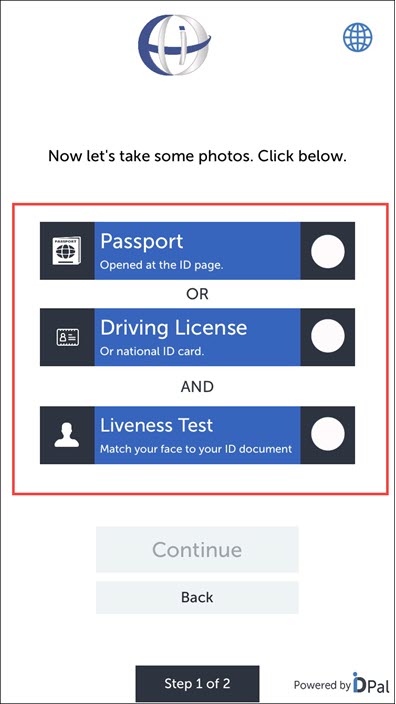
When IDPal confirms the signer's identity using the personal information and photos, they proceed to complete the signing process. A copy of the signer's Client Due Diligence Report is included with the completed package.
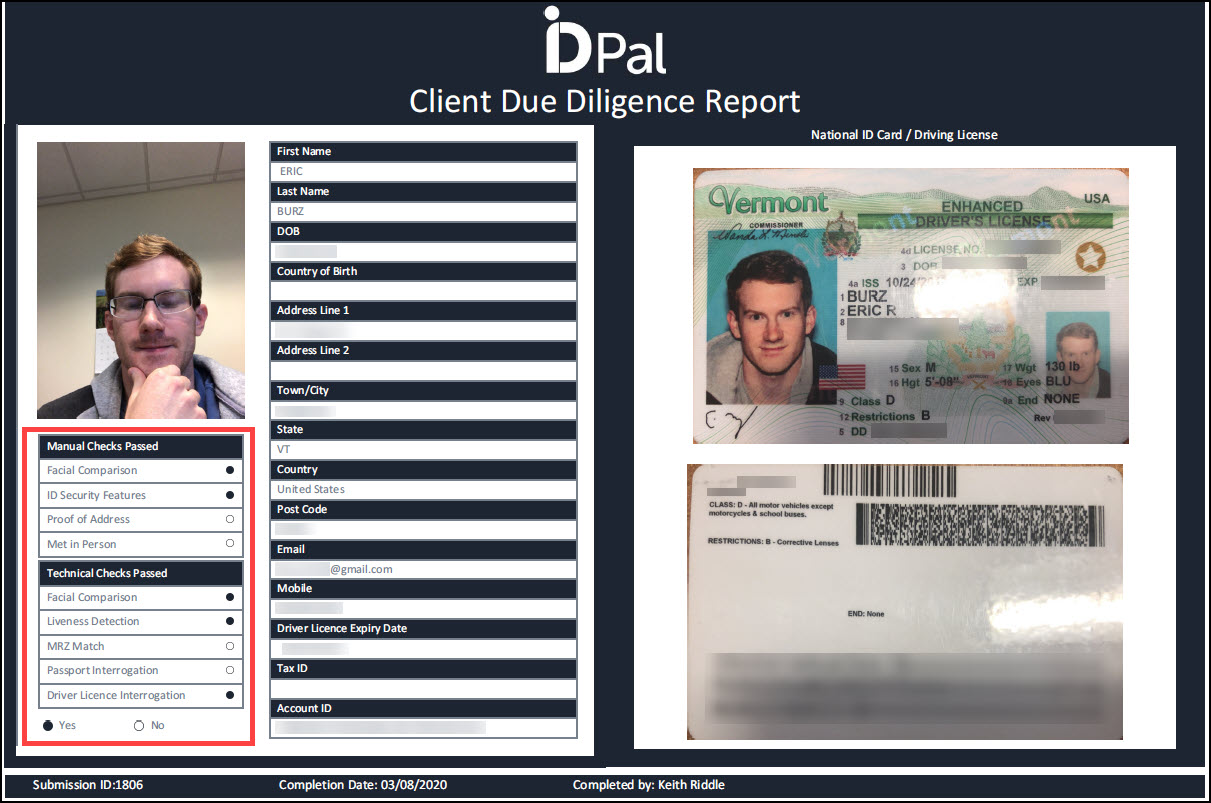
- To add a personal message to the email notification being sent to a signer, click the corresponding personal message icon
 . The Personal Message window appears.
. The Personal Message window appears.
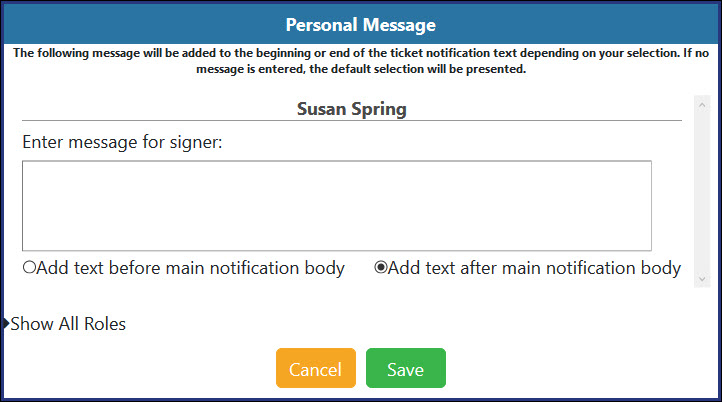
In the Enter message for signer field, enter a brief personal message.
Using the radio buttons beneath the field, select whether you want to Add text before main notification body or Add text after main notification body.
To enter a message for additional signer, click Show All Signers and enter a brief message for the desired signer(s).
When all signer personal messages have been entered, click Save.
Note: If you select Text as your message notification type, the personal message you enter will not appear in the text message notification sent to signers.
- To add a payment request for a signer, click the corresponding payment request icon
 . The Request Payment window appears.
. The Request Payment window appears.
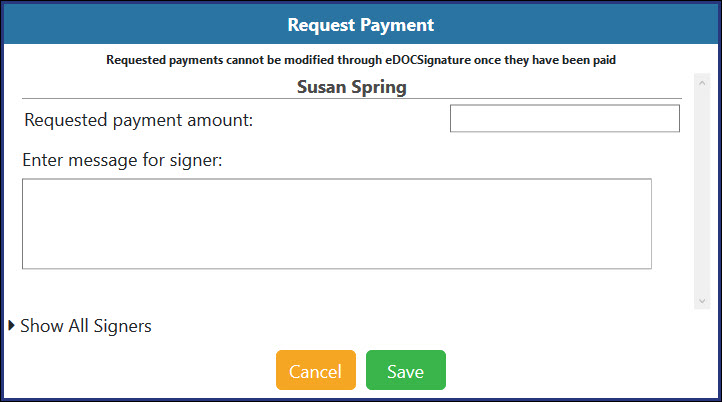
In the Requested payment amount field, enter a requested payment amount.
Optionally, in the Enter message for signer field, enter a brief message for the signer.
To request a payment from additional signers, click Show All Signers and enter a requested payment amount for the desired signer(s).
When all signer payment requests have been entered, click Save.
Notes:
– There is a fee associated with enabling payment requests in eDOCSignature. For more information, contact eDOC Client Development.
– Payment collection is managed by Helcim. You must have a Helcim account before requesting payments through eDOCSignature.
- When all desired signer role information has been entered, click Next to continue to the Index Data screen.
Alternatively, to send the package for signing directly from this screen, in the top-right corner, click Send Now. A message appears stating that the package has been sent for signing.
-OR-

- In the Signer Name field, enter the signer's name.
Alternatively, you can search for signers already in the system. To search for existing signers, enter at least four characters into the Signer Name field and click the Search icon .
. - In the Email field, enter the signer's email address.
View Signer Best Practice – One Email per SignerView Signer Best Practice – One Email per Signer
To protect identity during the signing process, it is recommended that you use only one signer per email address. To accommodate signers that share an email, the following best practice is recommended:
- Assign the first signer to "Group 1."
- Assign the second signer to "Group 2."
- Call each signer separately to deliver their authorization codes.
This process will send an email notification to the first signer. After the first signer has completed the signing process, an email notification will be sent to the second signer.
- From the Notification Type drop-down list, select a notification type.
View Notification Type DescriptionsView Notification Type Descriptions
When a package is sent, a notification is sent to each signer. There are four message notification types in eDOCSignature from which you can select when sending packages out for signing: Public, Text, Private, and No Email:
- Email – An email notification is sent to the signer. The email includes a hyperlink that brings the signer to the eDOCSignature signing pages.
- Text – A text message notification is sent to the signer. The text message includes a hyperlink that brings the signer to the eDOCSignature signing pages. This feature must be enabled by eDOC Client Development before it can be selected.
- Home Banking – An email notification is sent to the signer informing them to log in to their home banking site. Once logged in, the signer can view an additional message containing more information that has been transmitted to the home banking site via the message submission API. This additional message contains the hyperlink that brings the signer to eDOCSignature's signing pages.
- No Email – No email notification is sent to the signer. This option is mostly used for in-person (i.e. in-branch) signing.
- To require an authentication code for a role, in the Auth Code box, enter an authentication code.
View Authentication Code DescriptionView Authentication Code Description
An authentication code is a security tool that can be used to help verify the identity of a signer. When an authorization code is entered for a signer, an email is sent to that signer containing the authorization code. During the document signing process, the signer is prompted for this code and must enter it before proceeding any further. Authentication codes can be a combination of up to six letter and numbers.
- To require an ID Check for a role, from the ID Check drop-down list, select an ID Check type.
View ID Check Type DescriptionsView ID Check Type Descriptions
ID Check allows you to verify a signer's identity before the document signing process occurs using one of the methods described below. Access to each ID Check method is subscription-based and must be enabled by a member of the eDOC Client Development team.
IDology is an out-of-wallet service that screens signers using their personal information and a series of personalized questions. The service scours billions of public data records to intelligently derive tactful, non-invasive quesitons to authenticate an identity.

For each question, the signer has the option to choose "None of the Above" or "Skip the Question." Based on the number of questions answered correctly, your business can approve or deny the transaction. Once IDology confirms the signer's identity, they proceed to complete the signing process.
IDPal verifies a signer's identity by matching the information on their passport or driver's license with public data records. It also performs a "likeness test" using the signer's passport or driver's license photo and a current photo. Signers are sent a link to download the ID-Pal application on their mobile device. Once downloaded, signers use the application to upload a copy of their passport or driver's license as well as a current photo.

When IDPal confirms the signer's identity using the personal information and photos, they proceed to complete the signing process. A copy of the signer's Client Due Diligence Report is included with the completed package.

- To add additional signers to the package, click the in the top-right corner of the screen, click the green plus icon
 . A set of fields for a new signer appear.
. A set of fields for a new signer appear.
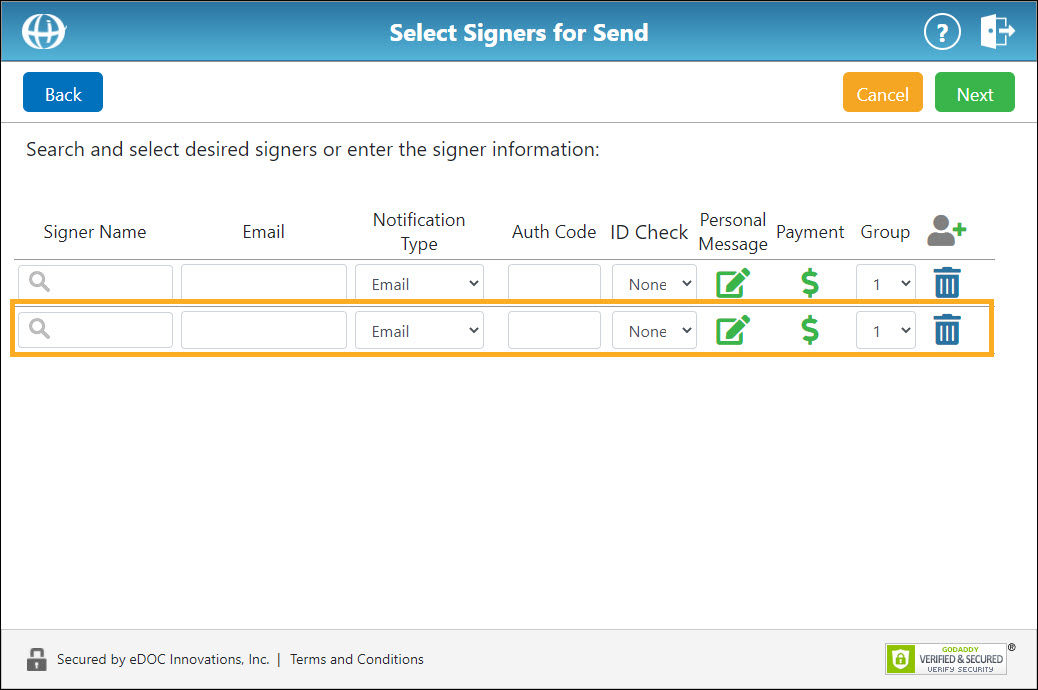
- To change the grouping order of signers, from the Group drop-down list for each signer, select a group number.
View Grouping Order DescriptionView Grouping Order Description
Grouping order refers to the order in which signers receive a document for signing. For example, if two signers are set to be included in "Group 1" and one signer is set to be included in "Group 2," the signer in "Group 2" will not receive the document for signing until both signers in "Group 1" have completed the signing process.
- To add a personal message to the email notification being sent to a signer, click the corresponding personal message icon
 . The Personal Message window appears.
. The Personal Message window appears.
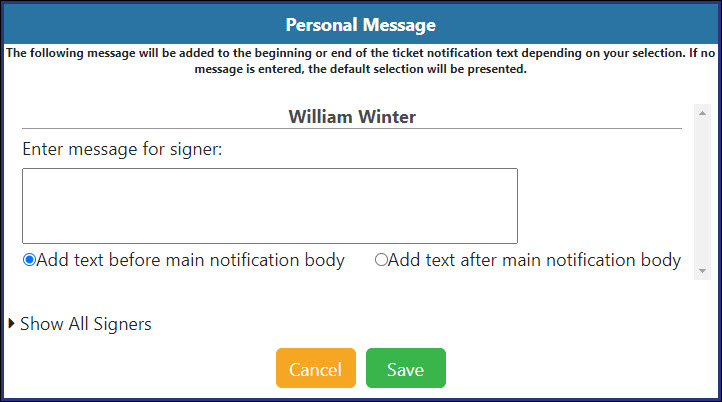
In the Enter message for signer field, enter a brief personal message.
Using the radio buttons beneath the field, select whether you want to Add text before main notification body or Add text after main notification body.
To enter a message for additional signers, click Show All Signers and enter a brief message for the desired signer(s).
When all signer personal messages have been entered, click Save.
Note: If you select Text as your message notification type, the personal message you enter will not appear in the text message notification sent to signers.
- To add a payment request for a signer, click the corresponding payment request icon
 . The Request Payment window appears.
. The Request Payment window appears.
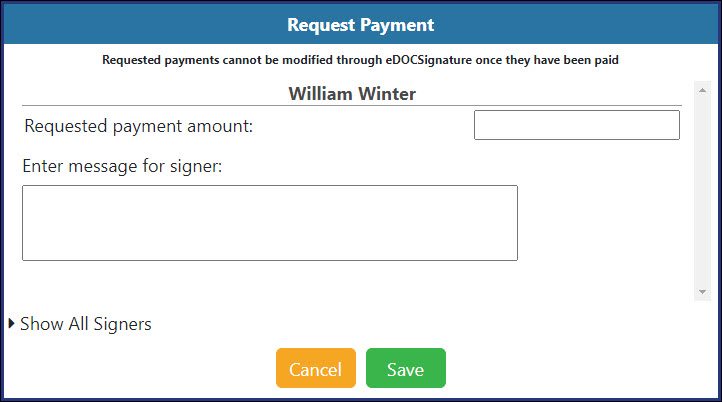
In the Requested payment amount field, enter a requested payment amount.
Optionally, in the Enter message for signer field, enter a brief message for the signer.
To request a payment from additional signers, click Show All Signers and enter a requested payment amount for the desired signer(s).
When all signer payment requests have been entered, click Save.
Notes:
– There is a fee associated with enabling payment requests in eDOCSignature. For more information, contact eDOC Client Development.
– Payment collection is managed by Helcim. You must have a Helcim account before requesting payments through eDOCSignature.
- To remove a signer from the package, click the corresponding trash can icon
 .
. - When all desired signers have been added to the package, click Next:
- If your package contains a signing document, you are brought to the Index Data screen.
- If your package contains one signer and no signing documents, you are brought to the Review Document Information screen.
- If your package contains multiple signers and no signing documents, you are brought to the Select Reference or Select Requested Viewers screen.